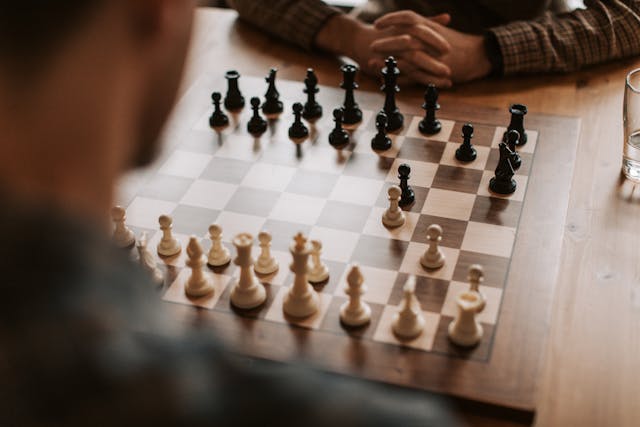Welcome to GertieBlu, where we explore the art, strategy, and beauty behind some of the world’s most intriguing hobbies and games. Today, we’re diving into the fascinating world of chess—a game that’s been played for centuries, captivating the minds of everyone from grandmasters to casual players.
Whether you’re new to chess or looking to brush up on the basics, this guide will help you understand the rules, how to play, and some key strategies to get you started.
What is Chess?
Chess is a two-player strategy board game that has been played for over a thousand years. It’s often called “the game of kings” because of its royal history and the complex strategic thinking it requires. The game is played on an 8×8 grid, known as a chessboard, with each player controlling 16 pieces.
The Chessboard and Pieces
Before you start playing, it’s important to understand the board and the pieces. The chessboard has 64 squares, alternating between light and dark colors. Each player starts with the following 16 pieces:
- 1 King: The most important piece. The objective of the game is to checkmate your opponent’s king, which means putting it in a position where it cannot escape capture.
- 1 Queen: The most powerful piece, capable of moving any number of squares in any direction—vertically, horizontally, or diagonally.
- 2 Rooks: These pieces move horizontally or vertically across the board and can cover long distances quickly.
- 2 Bishops: Bishops move diagonally, staying on squares of the same color they started on.
- 2 Knights: Unique in their movement, knights move in an L-shape: two squares in one direction and then one square perpendicular.
- 8 Pawns: Pawns are your front-line soldiers. They move forward one square at a time but capture diagonally. Pawns have a special first move where they can advance two squares.

Basic Rules of Chess
- Objective: The goal of chess is to checkmate your opponent’s king. A checkmate occurs when the king is in a position to be captured (in “check”) and there is no legal move to escape.
- Moves: Each type of piece has its own method of movement, as described above. You must move one piece per turn, except in the case of “castling,” where a player can move two pieces (the king and a rook) in one turn.
- Check: When a king is in a position to be captured, it is said to be in “check.” The player must make a move to remove the check by moving the king, blocking the check with another piece, or capturing the threatening piece.
- Checkmate: If a king is in check and cannot escape, the game ends in checkmate. The player delivering checkmate wins.
- Stalemate: If a player cannot make a legal move and their king is not in check, the game ends in a draw due to stalemate.
- Castling: A special move involving the king and one of the rooks. The king moves two squares toward the rook, and the rook moves to the square next to the king. This can only happen if neither the king nor the rook has moved before, there are no pieces between them, and the king is not in check.
- En Passant: A special pawn capture that can occur if a pawn moves two squares forward from its starting position and lands beside an opponent’s pawn. The opponent’s pawn can capture it as if it had only moved one square.
- Promotion: If a pawn reaches the farthest row from its starting position, it can be promoted to any other piece, typically a queen, as the queen is the most powerful piece.
How to Play a Game of Chess
Now that you know the rules, here’s a step-by-step guide to playing a game of chess:
- Set Up the Board: Position the board so that each player has a white square in the bottom right-hand corner. Place your pieces on the two rows closest to you, with pawns on the second row and the back row filled (from left to right) with a rook, knight, bishop, queen, king, bishop, knight, and rook.
- White Moves First: The player with the white pieces always moves first. Players then alternate turns.
- Opening Moves: Develop your pieces by moving your knights and bishops toward the center of the board. Control of the center is crucial in chess as it gives you more mobility.
- Midgame: This phase of the game involves positioning your pieces for an attack on your opponent’s king while protecting your own. Look for ways to create threats, capture key pieces, and gain a material advantage.
- Endgame: Once most of the pieces have been traded off the board, the game transitions to the endgame. In this phase, players focus on promoting pawns, creating checkmate threats, and securing a victory.
Basic Chess Strategies
- Control the Center: Dominating the center of the board gives your pieces greater mobility and more options for attack.
- Develop Your Pieces: Move your knights and bishops early in the game to position them for attacks and defense.
- Protect Your King: Early castling is a good way to safeguard your king and connect your rooks, making them more powerful.
- Think Ahead: Always consider your opponent’s possible moves. Anticipating their strategy is key to winning in chess.
- Don’t Rush: While it’s tempting to go for quick attacks, careful planning and gradual development often lead to better results.

Conclusion
Chess is a game of infinite possibilities, blending deep strategy with tactical brilliance. Whether you’re playing casually or aiming to improve your skills, the key is practice and patience. The more you play, the better you’ll understand the nuances and depth of this timeless game.
So set up your board, invite a friend, and start your journey into the world of chess. Happy playing!
Thanks for visiting GertieBlu—stay tuned for more guides, tips, and insights into your favorite hobbies and games!









